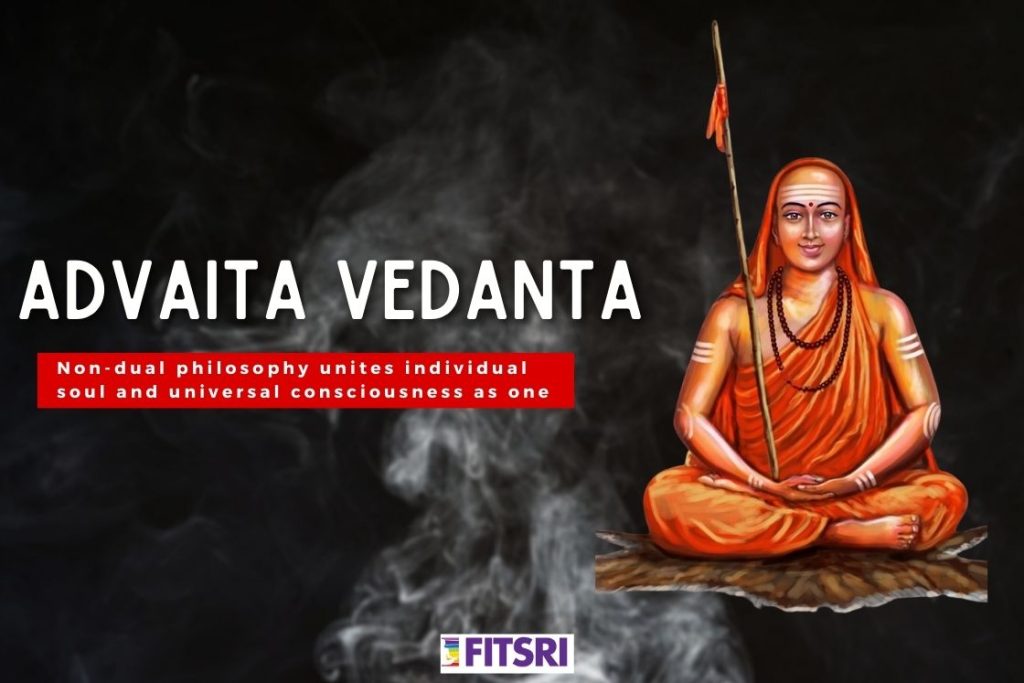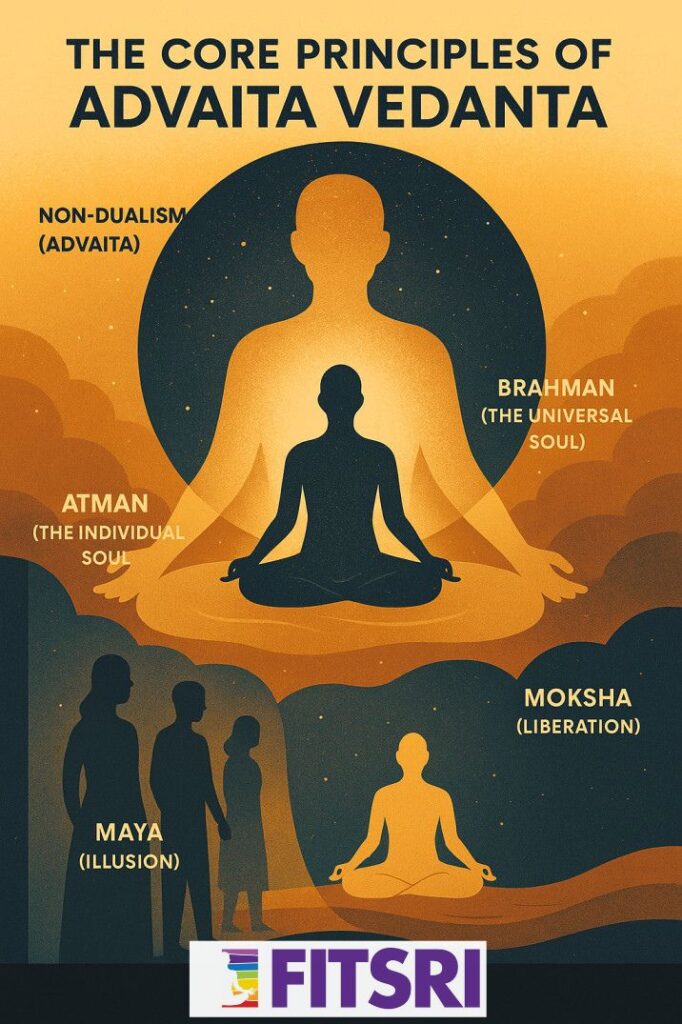
Advaita Vedanta is a deep and insightful school of Indian philosophy that teaches the oneness of all existence. It asserts that the individual self (Atman) and the ultimate reality (Brahman) are fundamentally one and the same. This tradition, deeply rooted in the ancient Vedic scriptures and Upanishads, explores the essence of consciousness, the illusion of separateness, and the path to self-realisation.
The term Advaita means “not two,” signifying the absence of duality between the observer and the observed, the knower and the known. Vedanta, meaning “the end of knowledge,” represents the pinnacle of Vedic wisdom insights that transcend intellectual understanding and point directly to the unity of all existence. At its core, Advaita Vedanta reveals that the experience of division is a result of ignorance (avidya), and liberation (moksha) arises through the direct realisation of oneness.each one of us. The sense of individuality or separation we feel is due to our limited perceptions.
Adi Shankaracharya is a Key Figure in Advaita Vedanta
Adi Shankaracharya was a great Indian philosopher and saint who played a major role in reviving Advaita Vedanta. Born in the 8th century, he taught that the soul (Atman) is not different from the ultimate reality (Brahman). His clear teachings and writings helped people understand the idea of oneness and self-realisation.
Today, his commentaries on the Upanishads, Bhagavad Gita, and Brahma Sutras are still followed. His work shaped the way Advaita Vedanta is studied and practiced, not just in India but around the world.
This is just a glimpse of Advaita Vedanta a path that offers deep insight into the nature of life and the self.
The core principles of advaita vedanta

Advaita Vedanta teaches that behind the diversity of the world lies one unified reality. These core principles help us understand ourselves and the universe through the lens of non-duality.
- Non-dualism (Advaita)
At the heart of Advaita Vedanta is the idea of non-dualism. This means there is no real separation in the universe. The word ‘Advaita’ itself means ‘not two.’ In simple words, everything and everyone are made of the same basic truth. We might see many different people, things, and shapes, but deep down, it’s all one connected reality
- Brahman (The Universal Soul)
Brahman is a main idea in Advaita Vedanta. You can think of it as the highest power or energy in the universe. It has no shape or limits and lasts forever. But it’s not like a god with a name or form. Brahman is beyond all that. It’s the hidden truth behind everything. When we talk about where the universe came from or what it’s made of deep down, we’re really talking about Brahman
- Atman (The Individual Soul)
Each of us has a true self inside, called the soul or Atman in Advaita Vedanta. The amazing thing is that this Atman is not separate from Brahman—the universal energy. Our soul is like a small spark of that great power. We feel separate from others only because we don’t see the full truth. When we understand our true self, we see that we are all part of one big, united reality
- Maya (Illusion)
If everything is one, then why do we feel separate from the world around us? In Advaita Vedanta, the answer is Maya. Maya means illusion. It’s like a curtain or filter that makes us see the world as divided and different. Because of Maya, we think we are separate from others and from the truth. One of the main goals in Advaita Vedanta is to see through this illusion and realise that everything is truly one.
- Moksha (Liberation)
Moksha is the main goal in Advaita Vedanta. It means freedom from the cycle of birth and death and from the illusion called Maya. When someone reaches Moksha, they understand that their soul (Atman) is the same as the universal truth (Brahman). They break free from all false ideas and feel completely connected with everything. It’s the final step in the journey of knowing who we really are
Scriptures and texts of advaita vedanta
Advaita Vedanta can feel deep and complex at first, but there are important texts that help explain its ideas clearly. These scriptures are like guides that lead us step by step toward understanding the truth about life, the universe, and the self.
- Upanishads
The Upanishads, often referred to as the spiritual heart of the Vedas, are ancient texts that explore the nature of reality and the self. They form the foundation of much of India’s spiritual philosophy. These texts are a collection of dialogues, discussions, and insights that examine the great questions of life. If you want to understand the core of Indian thought on topics such as existence, purpose, and the universe, the Upanishads are the best place to start.
- Brahma Sutras
The Brahma Sutras, also known as the Vedanta Sutras, serve as a systematic representation of the teachings found in the Upanishads. Authored by the sage Badarayana, these sutras are concise aphorisms that delve into the nature of Brahman, the ultimate reality. They are essentially a road map to guide the seeker through the vast landscape of Vedantic thought and help him navigate its intricacies.
- Bhagavad Gita
The Bhagavad Gita, arguably one of the most famous Indian scriptures, is a 700 verse dialogue between Prince Arjuna and the god Krishna, who serves as his charioteer. The Gita is more than just a religious book, for it deals with duty, righteousness, and the paths to spiritual realisation. It beautifully combines philosophy, theology, and guidance for personal growth, making it a text of immeasurable value to everyone, regardless of their background.
- Prakarana Granthas (introductory texts)
For those taking their first steps into Vedantic philosophy, the Prakarana Granthas are a boon. These are introductory texts, simplifying complex concepts and serving as a primer for the uninitiated. Authored by various sages and scholars, including the renowned Adi Shankaracharya, these texts break down Vedantic teachings into digestible bits, making the profound wisdom accessible to all.
Advaita vedanta’s relation to yoga
The connection between Advaita Vedanta and yoga creates a complete path for self-discovery. While Advaita Vedanta offers the philosophical roadmap, yoga provides the practical tools to walk that path. Together, they help us gain a deeper understanding of life, existence, and our true nature.
How It complements yoga philosophies
Advaita Vedanta and yoga might seem like separate streams of thought, but they beautifully dovetail into each other. At the core, both focus on the understanding and realization of the true nature of the self. While yoga is often associated with physical postures, its true essence lies in spiritual development, aligning seamlessly with the principles of Advaita Vedanta. Yoga offers practical tools for personal growth, and Advaita Vedanta provides the philosophical backbone. Together, they guide seekers towards a unified understanding of self and the universe.
Practices aligned with advaita principles
In yoga, certain practices resonate deeply with the teachings of Advaita Vedanta. The most notable among these is meditation focused on self-realization. Rather than merely being a relaxation tool, this form of meditation pushes one to peel back layers of perception, reaching the core essence of the self. The practice aids in dissolving the illusion of separateness (Maya), leading to the realization that the individual soul (Atman) and the universal consciousness (Brahman) are one. Breath control (pranayama) and ethical living (yama and niyama) are other yoga practices that bolster the journey of understanding and embodying Advaita Vedanta’s principles.
Advaita vedanta in modern times
The ancient philosophy of Advaita Vedanta remains as relevant and meaningful today as it was thousands of years ago. Its universal message, along with the efforts of modern teachers, continues to guide, inspire, and uplift people in today’s fast-paced world.
Contemporary teachers and teachings
The timeless wisdom of Advaita Vedanta lives on through modern voices who bring new life to these ancient teachings. Though not modern in the strictest sense, spiritual giants like Ramana Maharshi and Swami Vivekananda played a key role in making Advaita Vedanta accessible to people far beyond India’s borders. Today, teachers such as Mooji, Rupert Spira, and Adyashanti offer fresh and relatable perspectives that speak to the modern seeker. Through retreats, writings, and online sessions, they continue to spread the essence of non-dualism across the globe, keeping the spirit of Advaita Vedanta alive and thriving.
The Relevance of advaita Vedanta in the modern World
In a world of distractions and complexity, the simplicity and directness of Advaita Vedanta offer a refuge. Its core message – the interconnectedness of everything and the innate divinity within each of us – offers comfort and clarity. In an age grappling with individualism, materialism, and disconnectedness, Advaita Vedanta encourages introspection, unity, and true self-understanding. Its emphasis on self-realisation as the path to contentment contrasts with modern notions that external achievements are the primary sources of happiness.
The Global Appeal and Spread of its Teachings
Advaita Vedanta’s universal message of non-duality and inner peace transcends cultural and geographical boundaries. The teachings of Advaita Vedanta have found worldwide appeal, and study groups, retreats, and institutions dedicated to Advaita Vedanta are flourishing in various corners of the world. The universality of its principles–the pursuit of true self-knowledge and the realization of Oneness–appeals to the heart and makes it attractive to diverse populations. Whether in bustling metropolises or quiet rural areas, the voice of Advaita Vedanta finds eager listeners.
Practical applications of advaita vedanta
Embracing the principles of Advaita Vedanta doesn’t require a complete overhaul of your life. With gradual steps, consistent practice, and genuine intent, the profound wisdom of non-duality can illuminate every corner of your daily existence.
How to Apply Advaita Vedanta Principles in Daily Life:
The teachings of Advaita Vedanta, while profound, are not just theoretical musings but are rooted in the practicalities of living a fulfilling life. Here’s how you can incorporate its principles daily:
- Awareness: Regularly pause and be present. In the midst of a busy day, taking a moment to simply be aware of your surroundings and internal state can be a step towards recognizing the interconnectedness of all things.
- Non-Judgment: Approach situations and people without preconceived notions. This aligns with the idea of seeing the universal essence (Brahman) in everyone and everything.
- Simplicity: Minimize unnecessary clutter, both materially and mentally. This can help in perceiving reality without the distortions of Maya (illusion).
- Inner Reflection: Dedicate time daily for self-reflection, questioning the nature of your true self, and distinguishing between the ego and the Atman.
Techniques and Practices for Self-Realization
To truly understand and embody the teachings of Advaita Vedanta, certain practices can serve as guiding lights:
- Meditation: Start with a simple mindfulness meditation, focusing on your breath. Gradually, transition to self-inquiry meditation, where you contemplate questions like “Who am I?” to delve into the nature of your true self.
- Reading & Contemplation: Dive into core texts like the Upanishads or works by modern Advaita teachers. But don’t just read—reflect deeply on their teachings.
- Satsang: Attend gatherings or sessions with knowledgeable teachers or like-minded seekers. This shared pursuit can offer clarity and reinforce your understanding.
- Ethical Living: Align your actions with the principle of seeing the divine in all. This can mean practicing kindness, honesty, and non-violence in thoughts, words, and deeds.
Conclusion
Advaita Vedanta, at its core, delves into the profound truth of non-duality, asserting that all of existence is interconnected. This age-old philosophy, originating from India’s sacred texts, resonates deeply even today. It offers clarity amidst the chaos of modern living, emphasizing the innate divinity within each of us and the interconnectedness of all things.
In a world often marked by divisions and distractions, Advaita Vedanta stands as a beacon, guiding seekers towards unity, understanding, and inner peace. Its teachings are not confined to scriptures but are immensely practical, providing tools for self-reflection, self-realization, and genuine contentment.
In sum, Advaita Vedanta’s importance cannot be overstated. It bridges ancient wisdom and contemporary challenges, providing a timeless roadmap for anyone seeking deeper meaning, purpose, and connection in their lives. Whether you’re a spiritual seeker or simply someone looking for grounding in today’s world, the principles of Advaita Vedanta offer a foundation of enduring value.
Frequently Asked Questions related to Advaita Vedanta
1. Who is God in Advaita Vedanta?
In Advaita Vedanta, God is referred to as “Brahman.” Brahman is the ultimate, unchanging reality, amidst and beyond the world. It’s not a deity in the conventional sense but rather the supreme consciousness or universal principle that underlies everything.
2. What is the difference between Vedanta and Advaita Vedanta?
“Vedanta” is a term derived from “Veda-anta” (the end of the Vedas) and refers to the Upanishads, which expound on the philosophical teachings of the Vedas. Vedanta has several sub-schools, each interpreting these teachings differently. “Advaita” Vedanta, with “Advaita” meaning non-dual, is one of these sub-schools. It emphasizes non-duality, suggesting that the individual soul and the universal soul are one.
3. Who founded Advaita Vedanta?
While the roots of Advaita Vedanta can be traced back to the Upanishads, Adi Shankaracharya (often simply referred to as Shankara) in the early 8th century CE is credited with consolidating and systematizing its teachings. He is often regarded as the founder or key propagator of Advaita Vedanta.
4. Who is Shiva according to Advaita?
In Advaita Vedanta, Shiva is considered a representation of the Supreme Brahman. He symbolizes the consciousness that pervades everything. While traditional religious practices may worship Shiva as a deity, in Advaita philosophy, Shiva is a manifestation of the ultimate reality or consciousness.
5. Is Bhagavad Gita based on Advaita Vedanta?
The Bhagavad Gita encompasses various philosophical teachings, and different sections can be interpreted in line with different Vedantic sub-schools. Advaita Vedantins see the Bhagavad Gita as supporting their view, especially in chapters where the oneness of the self with the ultimate reality is emphasized. However, the Gita is not exclusively an Advaita text, as it also incorporates elements that resonate with other Vedantic schools.
6. Who are the 5 teachers of Advaita Vedanta?
While there have been numerous teachers and proponents of Advaita Vedanta, the tradition often speaks of a lineage of principal teachers, known as the Dashanami Sampradaya. Among them, five are particularly revered:
- Adi Shankaracharya: The primary consolidator of Advaita Vedanta.
- Padmapadacharya: A direct disciple of Shankara and author of several significant texts.
- Sureśvarāchārya: Another pivotal disciple of Shankara known for his works defending Advaita.
- Hastamalakacharya: Also a disciple of Shankara, known for his clarity on the teachings.
- Totakacharya: A renowned disciple of Shankara who composed influential verses on Advaita.
7. What are the three levels of reality in Advaita Vedanta?
Advaita Vedanta describes three levels of reality:
- Paramārthika Satyam (Absolute Reality): This is the highest level of reality, representing Brahman or the ultimate truth that is unchanging and eternal.
- Vyāvahārika Satyam (Empirical Reality): This is the level of reality we perceive in our daily lives – the world, people, objects. It’s considered real but is subject to change and thus is not the absolute reality.
- Prātibhāsika Satyam (Apparent Reality): This represents illusory or subjective reality, like dreams or hallucinations.




